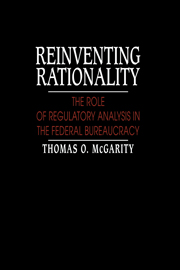Book contents
- Frontmatter
- Contents
- Acknowledgments
- Abbreviations
- Introduction
- Part I The clash of regulatory cultures
- Part II Regulatory analysis in theory and practice
- Part III Structuring regulatory analysis into the decisionmaking process
- 11 Roles for the regulatory analyst
- 12 The hierarchical model
- 13 The outside advisor model
- 14 The team model
- 15 The adversarial model
- 16 A hybrid model
- 17 Selecting the right model
- Part IV Review of regulatory analysis
- Part V Conclusions
- Notes
- Bibliography
- Index
14 - The team model
Published online by Cambridge University Press: 16 October 2009
- Frontmatter
- Contents
- Acknowledgments
- Abbreviations
- Introduction
- Part I The clash of regulatory cultures
- Part II Regulatory analysis in theory and practice
- Part III Structuring regulatory analysis into the decisionmaking process
- 11 Roles for the regulatory analyst
- 12 The hierarchical model
- 13 The outside advisor model
- 14 The team model
- 15 The adversarial model
- 16 A hybrid model
- 17 Selecting the right model
- Part IV Review of regulatory analysis
- Part V Conclusions
- Notes
- Bibliography
- Index
Summary
The team approach is by far the most prevalent decisionmaking model in federal regulatory agencies. The primary subordinate decisionmaking entity in this model is a team, or work group, composed of representatives from all of the institutional subunits within the agency that have an interest in the outcome of the rulemaking process. Typically, a team is composed of representatives from the program office, the research and development office, the policy office, the Office of General Counsel (or Solicitor's Office), the enforcement office, and one of the agency's regional or field offices. The team meets periodically to discuss regulatory options, to examine problem areas, to respond to requests of upper-level decisionmakers, and to resolve disputes among team members. Although the program office usually has responsibility for the rulemaking effort, the group often delegates tasks to individual members of the team or to small subcommittees. Copies of memoranda, rulemaking and regulatory analysis documents, and other decisionmaking documents are circulated to team members for review and comment. All team members are regarded as coequal participants in the decisionmaking process, and there is usually strong pressure, deriving from both the group psychology of the effort and from upper-level decisionmakers, for the team to reach consensus on important questions.
Mechanisms for resolving disputes on teams vary. Sometimes disputes are resolved by votes, with the minority acquiescing in the majority's decision. Usually, dissenters are allowed to elevate disputes through formal or informal channels to higher levels for resolution. A team member, however, can only elevate dissents a limited number of times without fracturing the overall consensus necessary for the effective operation of the team.
- Type
- Chapter
- Information
- Reinventing RationalityThe Role of Regulatory Analysis in the Federal Bureaucracy, pp. 209 - 228Publisher: Cambridge University PressPrint publication year: 1991



